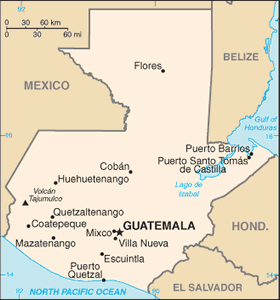The Geography of Guatemala
The Geography of Guatemala
Guatemalan Geography
Location: Central America, bordering the North Pacific Ocean, between El Salvador and Mexico, and bordering the Gulf of Honduras (Caribbean Sea) between Honduras and Belize
Geographic coordinates: 15 30 N, 90 15 W
Map references: Central America and the Caribbean
Area: total: 108,890 sq km land: 108,430 sq km water: 460 sq km
Area - comparative: slightly smaller than Tennessee
Land boundaries: total: 1,687 km border countries: Belize 266 km, El Salvador 203 km, Honduras 256 km, Mexico 962 km
Coastline: 400 km
Maritime claims: territorial sea: 12 nm exclusive economic zone: 200 nm continental shelf: 200 m depth or to the depth of exploitation
Climate: tropical; hot, humid in lowlands; cooler in highlands
Terrain: mostly mountains with narrow coastal plains and rolling limestone plateau
Elevation extremes: lowest point: Pacific Ocean 0 m highest point: Volcan Tajumulco 4,211 m
Natural resources: petroleum, nickel, rare woods, fish, chicle, hydropower
Land use: arable land: 13.22% permanent crops: 5.6% other: 81.18% (2005)
Irrigated land: 1,300 sq km (2003)
Natural hazards: numerous volcanoes in mountains, with occasional violent earthquakes; Caribbean coast extremely susceptible to hurricanes and other tropical storms
Environment - current issues: deforestation in the Peten rainforest; soil erosion; water pollution
Environment - international agreements: party to: Antarctic Treaty, Biodiversity, Climate Change, Climate Change-Kyoto Protocol, Desertification, Endangered Species, Environmental Modification, Hazardous Wastes, Law of the Sea, Marine Dumping, Ozone Layer Protection, Ship Pollution, Wetlands, Whaling signed, but not ratified: none of the selected agreements
Geography - note: no natural harbors on west coast


